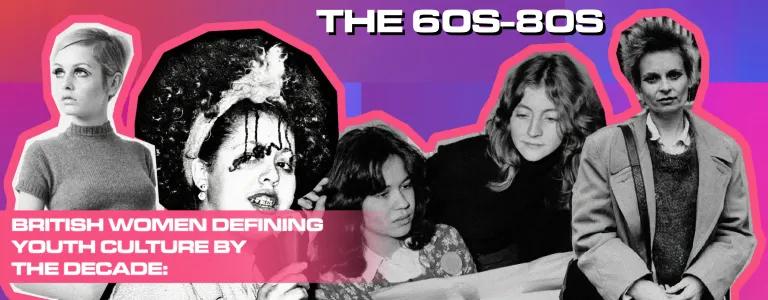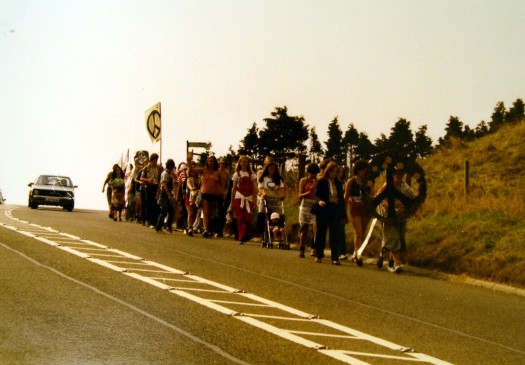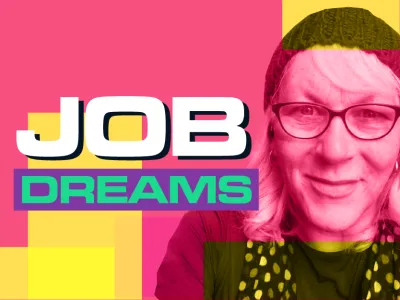
British Women Defining Youth Culture By The Decade: The 60s-80s
Include this article in your Skills Builder Journal. It could help you develop... 
We’re back with another By The Decade series, where we explore moments in time that have created an impact or defined how we live now. This series, we’re looking at the British women who helped shape, define, and change youth culture as we know it. Because let’s face it, youth culture is - and always has been - massively influential. From fashion to activism, the music industry to advertising, many people look to the young people of the generation to make decisions that affect, or create, change.
So let’s start by taking it all the way back to the 1960s…
This decade was all about the Mods, or, people in the Modernist movement. This movement was made up of young people from a working class background, and hugely influenced by African American R&B bands and British jazz groups of the late 1950s. They rebelled against the austerity of their parent’s generation and looked to new places for inspiration. UK fashion had a new identity, which was inspired by the sophistication and suave of the French and Italians. Men wore sharp tailored suits, polo shirts and detailed accents, and for women, it was all about geometric patterns, block colours, and the mini skirt.

One woman who really helped define this movement and become an icon for the times (and beyond!) was Twiggy. She was one of the first international supermodels of all time, and at just five foot six inches, she shook up her industry and the world. Not only was Twiggy “too short to be a model”, but her androgynous look also gave way to many young people finding themselves and feeling more comfortable in the way they looked - especially as when she broke into the scene, she was only 16 herself, so really resonated with the youth culture that she would go on to define! Twiggy was named “The Face of 1966” and is now commonly known as Queen of the Mods. Her blonde pixie cut, graphic eyeliner and heavily mascaraed eyelashes became synonymous with the movement and the whole decade!
When the 1970s rolled around, things started to change. The ‘gentle’ nature of Mod was out, and a new generation of rebellion was in. Punks took over the mainstream and youth culture was all about fierce self-expression and creativity. Punks wanted to draw a line in the cultural sand and reboot what everyone thought of young people. There were safety pins in clothing, mohawks on top of heads, snarls on faces, attitude everywhere, and most importantly, a platform for women to break free and speak up for themselves and what they believed in.

One of the most iconic women from the punk movement was Marianne Joan Elliot-Said, or, as she was more commonly known, Poly Styrene, the founding member and frontwoman of punk band, X-Ray Spex. Poly grew up in Brixton with her English mum and Somali father, and when she was 15, she ran away from home with just £3 in her pocket, to go to a string of music festivals (not recommended by us, lol). It was here that she first saw the Sex Pistols perform, and she fell in love with punk. X-Ray Spex quickly followed and created a new mould for young punks all over the country. Poly was described by Billboard as “the archetype for the modern-day feminist punk” because she wore braces on her teeth, rebelled against the achetypal female sex objects of the decade, wore bright colours and an old fashioned war helmet on her head. And, in a movement that was dominated by white men, the fact that Poly was a young, Black woman, who spoke her mind and didn’t want to fit into the notion that ‘little girls should be seen and not heard’, made her all the more iconic for the culture then, and now.
Two other women who challenged narratives and stood up for what they believed in, were Rosie Boycott and Marsha Rowe - the founders of Spare Rib magazine. Spare Rib was at the forefront of the Women’s Liberation Movement of the ‘70s and was created to challenge the male narrative of mainstream press, and redefine what it was to be a woman in 20th century Britain. And so Spare Rib became a monthly magazine, made by women, for women. It was different to other women’s magazines - which usually focused on beauty, romance and home life - and instead reached out to women from all backgrounds, to raise awareness of inequalities and challenge traditional and stereotypical representations of gender. The magazine covered topics like ‘what is a liberated woman?’, detailed features on women’s history, conversations about women’s pay, how to break ‘traditional’ roles and learn ‘predominantly male’ tasks like how to put up shelves, and gave women from all over the country the chance to collaborate and work with the magazine, writing articles themselves. It was at the heart of feminist campaigns, and was so successful it ran for over twenty years!
When the 1980s came around, the punk scene was still strong, but it broke off into different trends, most notably, the New Romantics - a movement credited to the group of young people (the likes of Boy George and Princess Julia) named The Blitz Kids, who went to a club night every Tuesday in Covent Garden called Blitz. New Romantics swapped the harsh, torn up image of punk for decadent fantasy - lots of bright colours, frilled shirts, graphic makeup and lavish materials like velvet and silk. And while the look might have changed, the thoughts, voices, and feelings of the youth were continuing on the same fight as decades before them - they wanted equality, leadership and focus. They wanted to be heard, and to be unabashedly themselves. They wanted positive change.
A group of women leading this change were the Women for Life on Earth. In the early 80s, they marched from Cardiff to RAF Greenham Common to demand the removal of 96 Cruise nuclear missiles that were to be located on the base. The women set up a peace camp and practised non-violent, direct action. The march highlighted the fact that women were active and prominent in the peace movement and in the campaign against nuclear weapons. They felt that the hard work of many women in local disarmaments groups wasn’t reflected in public speeches, and believed that women’s voices should be heard, so the march would be a platform for them, and other women they met along the way to stand up and speak out. The peaceful protest would become one of the most significant protests of the 20th century, and lasted nearly two decades.

Another woman who defined the decade was Vivienne Westwood. Vivienne had been designing and selling clothes since the early 70s, but it wasn’t until 1981 that she debuted her first proper collection - Pirates - and dominated the fashion world, and the lives of young people all over the country. The collection explored post-punk androgyny and was highly influenced by 18th century men’s clothing. Over the course of the decade, Vivienne continued to create dramatic, iconic clothing, reinventing English heritage and using traditional fabrics such as tweed and tartan. Her aesthetic and attitude allowed people to reinvent themselves - over and over! - show their rebellious sides, and be a bit provocative, from the 1980s to today!

Keep your eyes peeled for our next instalment when we take a look at the 1990s and some of the incredible British women who defined the decade. And if there are any women that you think shaped youth culture that we’ve missed out, let us know over on Insta at @NCS!




